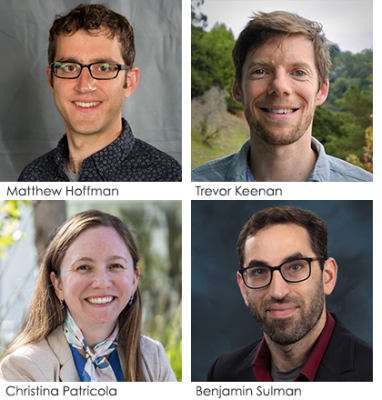Four EESM-Connected Scientists Receive DOE Early Career Awards
The U.S. Department of Energy (DOE) recently announced the selection of 76 scientists from across the nation to receive funding for research as part of the DOE Office of Science’s Early Career Research Program.
Four awardees plan research projects connected to Earth and Environmental Systems Sciences (EESM). They include:
- Matthew Hoffman, Los Alamos National Laboratory
- Trevor Keenan, University of California - Berkeley
- Christina Patricola, Iowa State University
- Benjamin Sulman, Oak Ridge National Laboratory
Hoffman’s research project, “Creating a Sea-Level-Enabled E3SM: A Critical Capability for Predicting Coastal Impacts,” aims to improve projections of how future sea level will vary around the globe by adding the ability to predict regional sea-level changes directly within DOE’s Energy Exascale Earth System Model (E3SM). This is a capability currently missing from earth system models. This new approach will be used to assess the accuracy of existing methods that rely on adding disparate, non-interacting contributions to sea level. The project can provide a tool for predicting regional sea-level targeted to agency needs and allow E3SM to address future coastal impacts of a changing climate.
Keenan’s project, “Extreme Drought, Heat and Wildfire Impacts on Future Coastal Water Relations,” looks at the role that ecosystem water use plays in determining surface water availability, and thus streamflow, and society’s water resources. This research will measure the impact of extremes, such as drought, heat, and wildfire on water relations of the coastal western US, integrating machine learning, earth system models, and emulators with distributed sensor networks, such as AmeriFlux. Combining both the water and carbon cycles with associated uncertainties, this work can improve understanding of the relationship between coastal ecosystem function and current and future water resources.
Patricola’s project, “Variability and Change in Tropical Cyclone Characteristics: Coupled Atmosphere-Ocean Drivers and Coastal Impacts,” aims to improve the resilience of North American coastal systems to climate change by understanding the atmospheric and oceanic controls on historical and future tropical cyclone characteristics. Her research will quantify how local-scale processes and atmosphere-ocean interactions shape tropical cyclone intensity in a changing climate; determine the primary large-scale physical drivers that control the spatial and temporal statistics of landfalling tropical cyclones; and quantify coastal impacts due to storm surge, heavy precipitation, and strong winds associated with tropical cyclones and sea-level rise.
Sulman’s project, “Simulating Estuarine Wetland Function: Nitrogen Removal, Carbon Sequestration, and Greenhouse Gas Fluxes at the River-Land-Ocean Interface,” will study how wetlands respond to interactions between freshwater from rivers and saltwater from the ocean, which drive high ecosystem productivity and dynamic carbon and nutrient cycling. The research will aim to understand the current and future role of estuarine wetlands in coastal carbon and nitrogen cycling at scales, from the estuary landscape to the continental coast by simulating estuarine wetland processes in the E3SM Land Model.
Now in its 11th year, DOE’s Early Career Research Program is designed to bolster the nation’s scientific workforce by providing support to exceptional researchers during crucial early career years, when many scientists do their most formative work. The research grants are planned for five years and will cover salary and research expenses. Awardees were selected from a large pool of university- and national laboratory-based applicants.

